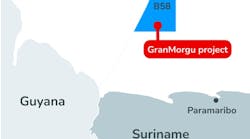Almost unlimited vertical loading
Heavyweight platforms are subject to extra stresses during float-over oper-ations. Paulstra, a specialist in vibration suppression/shock absorption, has contributed to some of the most ambi-tious installations of recent times in West Africa and the Far East.
The Paris-based company has more than 20 years experience working in the offshore sector. It designs circular deck support devices and shock absorbers for installation in the platform's legs – both incorporating large elastomeric springs. The deck systems support the weight of a large integrated deck during transportation on a barge and subsequent offloading at the offshore location via ballasting. The shock absorbers come into play during mating of the deck with the pre-installed jacket.
All systems are tailored to the platform's marine environment, and all are tested and manufactured at Paulstra's plant in Normandy, northern France.
"Our systems offer almost unlimited vertical loading, and a high stroke of up to 1 meter, equivalent to 50% of the elastomer thickness," says Oilfield Product Manager Georges Korbuly. "They are also very compact, compared with our competitors' models." Typically, the elastomer spring systems weigh between 250 and 4,000 kg, and can each support a load varying from 500 to 10,000 tonnes. Stroke is dependent on the number of elastomeric rings. These are normally produced in diameters up to 2.5 m.
Paulstra's techniques were first applied on a large-scale platform at Elf's Cobo field offshore Angola in 1995, working with installation contractor Technip. The two companies also collaborated in 2002 for Total's Amenam platform offshore Nigeria. The same year, Paulstra was subcontracted by Stolt Offshore for Shell's Forcados Yokri installation in the Niger Delta.
null
Normally, Paulstra's involvement starts one year into a field development. Headquarters in Levallois Perret provides conceptual engineering, shop drawings, and finite element analysis, and on-site cooperation with the platform fabricator. Designs often have to be modified late on in the construction process, sometimes even after the deck has been weighed on leaving the yard.
"Deck weight is often not well known at the start of a project," Korbuly explains. "It can go up if new equipment such as turbines is specified. If necessary, we can alter the diameter of the rings, or adapt the elastomeric elements, even at a very late stage."
Following Amenam, the focus switched last summer to the eastern Timor Sea, where ConocoPhillips' Bayu Undan gas field development was coming together. Here Paulstra supplied a total of 16 leg-mating units (maximum load 2,000 tonnes, deflection of 800 mm) and eight deck support units (max. load 1,000 tonnes, 500 mm deflection) for two giant platforms, under contract to the Clough/Aker joint venture. The jackets had been pre-installed. Both the decks, weighing 11,500 and 13,900 tonnes, were transported from Hyundai in Ulsan on a Dockwise barge for installation via the float-over method.
On arrival at the offshore location, the vessel was positioned between the jacket legs. The operation started through activation of the deck support units, followed by ballasting of the vessel's water tanks. The vessel was then lowered for the load transfer. As each deck was connected to its jacket, shocks induced by the vessel's motions were absorbed by the six-ring leg-mating units, operating at a stroke of 0.8 m. Once mating had been effected, the legs were welded to the deck, with all mating units remaining within the legs.
Currently, Paulstra is adapting its systems to withstand much greater loads for a new development, where two 30,000-tonne decks will be installed on concrete gravity bases during May-June 2005 and 2006.
Here the leg mating unit vertical load is 5,000 tonnes, with a corresponding deflection of 750 mm. The horizontal load is 3,000 tonnes.




